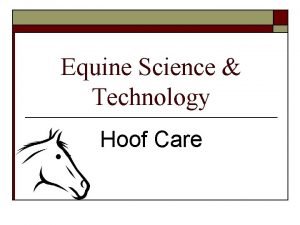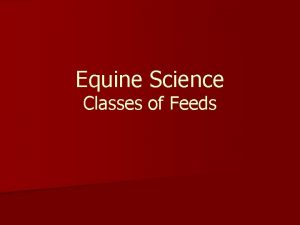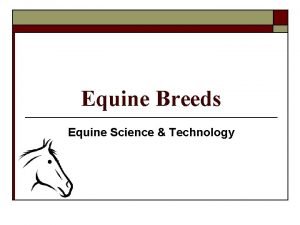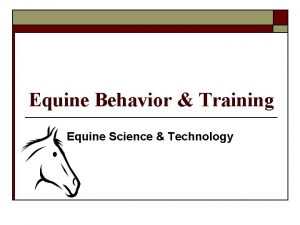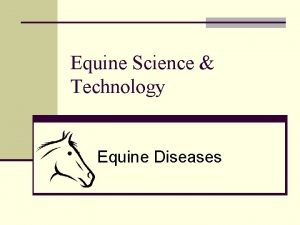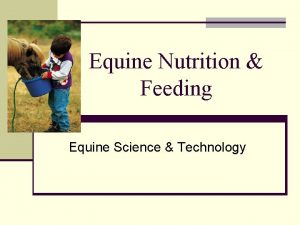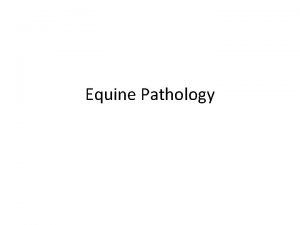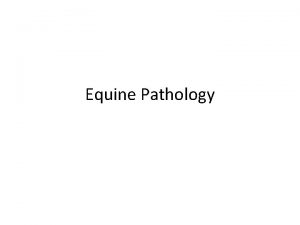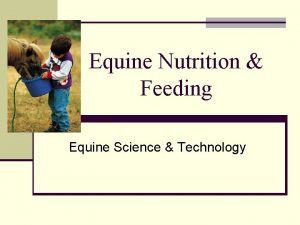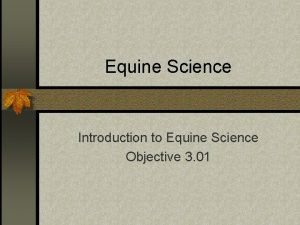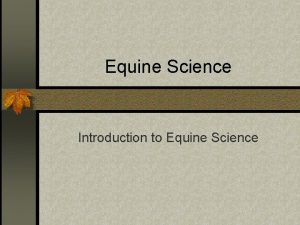Equine Anatomy Physiology Equine Science Technology Equine Anatomy













- Slides: 13

Equine Anatomy & Physiology Equine Science & Technology

Equine Anatomy

Equine Anatomy Equine Bodily Systems Ø Ø The skeleton of the horse consists of 206 bones. The muscular system provides movement both internally and externally The digestive system converts feed into a form that can be used by the body for maintenance, growth, and reproduction. Sexual reproduction is the process of creating new organisms of the same species through the union of male and female sex cells-sperm and eggs.

Equine Anatomy Skeletal System Ø Ø The skeletal system is the rigid framework that gives the body shape and protects the internal organs. It is composed of bone and cartilage. Bones are composed of one part organic matter and two parts inorganic matter. The bones and joints together compose a complex system of levers and pulleys, which combined with the muscular system give the body the power of motion.

Equine Anatomy Bones are classified by their shape as long, short, flat, and irregular. Ø Ø Long bones are found in the limbs. They support the body weight and act as the levers of propulsion. Short bones occur chiefly in the knee and hock and aid in the dissipation of concussion (the shock of impact) Flat bones, such as the ribs, scapula, and some of the bones of the skull, help to enclose cavities containing vital organs. Irregular bones are unpaired bones, such as the vertebrae and some of the bones of the skull.

Equine Anatomy Muscular System Ø Ø Ø The muscular system provides movement both internally and externally. Muscles are the active organs of motion and are characterized by their property of contracting or changing shape when stimulated. Each muscle is supplied by one or more nerves that bring commands from the brain to make it contract.

Equine Anatomy Muscular System Ø Ø Muscles compose about 50 percent of the total body weight. The muscle system is made up of three types of muscles Ø Ø Ø smooth or involuntary, cardiac or involuntary striated, and striated or skeletal muscle.

Equine Anatomy Digestive System The digestive system converts feed into a form that can be used by the body for maintenance, growth, and reproduction. Ø It consists of all the parts of an organism involved in taking food into the body and preparing it for assimilation, incorporation into the body. Ø In its simplest form, the digestive system is a tube extending from the mouth to the anus with associated organs.

Equine Anatomy Digestive System Ø Ø Ø This includes the mouth, esophagus, stomach, intestines, anus, and other associated organs like the liver, teeth, pancreas, and salivary glands. The entire digestive tract of a mature light horse is approximately 100 feet long, and has a total capacity of about forty to fifty gallons. Approximately 65 percent of the capacity of the digestive system is in the cecum and colon, which digests the forages consumed by the horse.

Equine Anatomy Reproductive organs of the stallion Ø The primary sex organ of the stallion is the testicle, of which there are two. Ø Ø The testicles produce sperm and a hormone called testosterone, which regulates and maintains the male reproductive tract, and is responsible for the masculine appearance and behavior of the stallion. Sperm production takes place within the testicles in the seminiferous tubulesØ a mass of minute, coiled tubules, the inner wall or surface of which produces the sperm.

Equine Anatomy Reproductive organs of the stallion Ø Theses tubules merge into a series of larger ducts, which carry the sperm to a coiled tube called the epididymis. Ø Ø The epididymis is the place where the sperm are stored and where they mature. The testicles and epididymis are enclosed in the scrotum Ø The scrotum’s chief function of which is thermo-regulatory – to maintain the testicles temperatures several degrees cooler than the body proper.

Equine Anatomy Reproductive organs of the stallion Ø From the epididymis the sperm move through a tube, the vas deferens, into the urethra. The urethra has a dual role; Ø Ø Ø Urine is carried from the bladder through the penis, and Sperm is carried from the junction with the vas deferens to the end of the penis. Along the urethra are the accessory sex glands- the prostate, the vesicular glands (seminal vesicles), and the bulbourethral (Cowper’s) glands. Ø Ø Their fluids nourish and preserve the sperm and provide a medium for its transport. The combined sperm and fluid is called semen.

Equine Anatomy Reproductive organs of the mare Ø The primary sex organ of the mare is the ovary, of which there are two. Ø Ø The ovaries are bean-shaped organs, 2 to 3 inches long that produce eggs. Each egg is contained in a bubble-like sack called a follicle. Ø Ø There are hundreds of follicles on every ovary. When the follicle is about 1 in. in diameter a hormone causes it to rupture and discharge the egg. Ø This process is known as ovulation.
 International anatomy olympiad
International anatomy olympiad Science olympiad forensics cheat sheet
Science olympiad forensics cheat sheet Equine science
Equine science Equine science
Equine science Science fusion introduction to science and technology
Science fusion introduction to science and technology Eric’s favourite .......... is science. *
Eric’s favourite .......... is science. * Anatomy of upper respiratory tract
Anatomy of upper respiratory tract Tattoo anatomy and physiology
Tattoo anatomy and physiology Incomplete flower
Incomplete flower Bone anatomy and physiology
Bone anatomy and physiology Gastric ulcer vs duodenal ulcer
Gastric ulcer vs duodenal ulcer Cantlie line
Cantlie line Epigastric region
Epigastric region Wpigastric region
Wpigastric region


